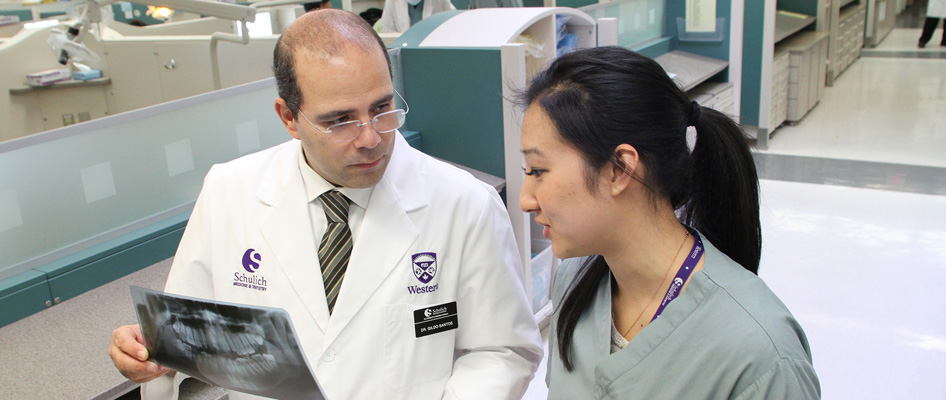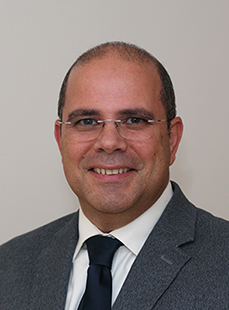Dental clinics: Enhancing learning and patient care

Dr. Gildo Santos was appointed Assistant Director, Clinical Affairs for Schulich Dentistry in 2017. We spoke to Dr. Santos about his new role, his vision for the future and the importance of clinical education.
What does your role as Assistant Director, Clinical Affairs entail?
 The clinic is the core of the dental industry. At Schulich Dentistry, we offer the education, the research, and the service components of learning. I am responsible for the service component in managing the clinics, including the Simulation Laboratory.
The clinic is the core of the dental industry. At Schulich Dentistry, we offer the education, the research, and the service components of learning. I am responsible for the service component in managing the clinics, including the Simulation Laboratory.
It’s my job to ensure that we have a sufficient number of patients and that we have the right kind of patients, so that the needs of both the patient and the student can be met. We have a number of dentists and mentors who help with the screening process to select the cases, and then we assign the patient cases to the students.
We have an amazing team that is extensively involved in scheduling patients, students and faculty. From the first day to graduation, the daily activities involved in running the clinics are planned. With approximately 130 part-time faculty and 27 full-time faculty members, scheduling and improving clinic experience can be a challenge, and we are constantly working to improve the experience of our clinics for students, faculty and patients.
What does the clinical experience at Schulich Dentistry look like for students?
Students spend the first two years in the pre-clinical Simulation Laboratory, practising before moving on to the other clinics. Our state-of-the-art Laboratory houses 60 patient simulation units. Each of these units contains an anatomically correct 'phantom head' and standard dental equipment. This clinic provides students the opportunity to learn techniques and procedures in an environment that closely simulates the real dental operatory.
We’ve designed the curriculum in a way that looks like a pyramid, with clinical experience becoming increasingly important by the top of the pyramid.
The first year of the Program provides students with the fundamental basic and clinical sciences necessary to complete patient assessment. It begins with core knowledge lectures in first year, emphasizing the integrated, thematic multidisciplinary approach to dental education.
The second year emphasizes integration of knowledge, diagnosis and treatment planning skills. Year 3 continues the theme of diagnosis and treatment planning transferring applied knowledge at a more complex level, and Year 4 focuses on patient care and elective opportunities.
Schulich Dentistry strives to provide comprehensive, patient-based care where students see their patients through the continuum of care from initial examination through all the various phases of treatment. Senior students rotate through hospital-based dentistry experiences and have exposure to various dental practices.
What is your vision for the future of the dental clinics? What are you trying to accomplish?
We are trying to increase clinical experience time for our students. I have already worked on a number of creative ways we can increase clinical time, as we are undergoing a renewal process in our School. It’s my role to implement a new model that has been discussed by the renewal committee, which will increase clinical time for our students.
Meanwhile, I need to be creative until that happens. I am reviewing where I can change lecturing times and if I can make any openings, to increase time. Already, I have some sessions that will be available for students in the next academic year.
Why is it important that students get a comprehensive clinical experience?
We need our students to understand the needs of our patients, which they gain through clinical experience. As dental students and future professionals, they make a commitment to taking care of their patients as a whole.
We train them to be dentists in private practice, so by the end of their training we expect them to be competent, skilled and effective dental practitioners. Getting more clinical sessions allows them to see their patients more often, which enhances their learning and also helps their patients receive consistent oral health care.
What is unique about Schulich Dentistry's clinics?
The clinic experience we have here is unique. There is a community of faculty, as there are a number of full time faculty, but also a fair amount of dedicated part-time faculty members who continue to teach and mentor the next generation. They bring different perspectives and knowledge, which greatly enhances the clinical experience for students.
Every community also has its own unique patient needs. There are different populations in our Southwestern Ontario region, compared to Toronto or other cities, so the care the patients receive must also be different. Our Dental Outreach Community Service (DOCS) program plays a role in the delivery of service to those in need, and increases access to care for some community members.
During the course of your time teaching here, what has changed about clinical education?
Trends in dentistry and technology are constantly changing and evolving. One thing we’ve noticed is that the concept of minimally invasive dentistry is gaining big momentum, which is bringing back procedures that 10 to 20 years ago were deemed obsolete. An example is onlays (or half crowns). Before, we were heavily focused on crowns. In the past five to seven years, there has been a shift in mentality, so we have started focusing more on onlays and incorporating that teaching into the clinical experience for our students.
We also have CAD/CAM technology that we piloted about 10 years ago. At that time we were the first dental school in Canada to have this type of teaching with a clinical component introduced into the undergraduate program.
What motivates you in this role? What makes you come back to work every day?
The challenges. Every day is different, so I’m never bored. What encourages me is how the School invests in us as faculty members. The School has a commitment to advancing the careers of its faculty and staff, through things like leadership courses, teaching certificates, and professional certificates. These programs have helped me to understand how to manage change, conflict, and the moving pieces that come with being part of a large institution like Schulich Medicine & Dentistry.








